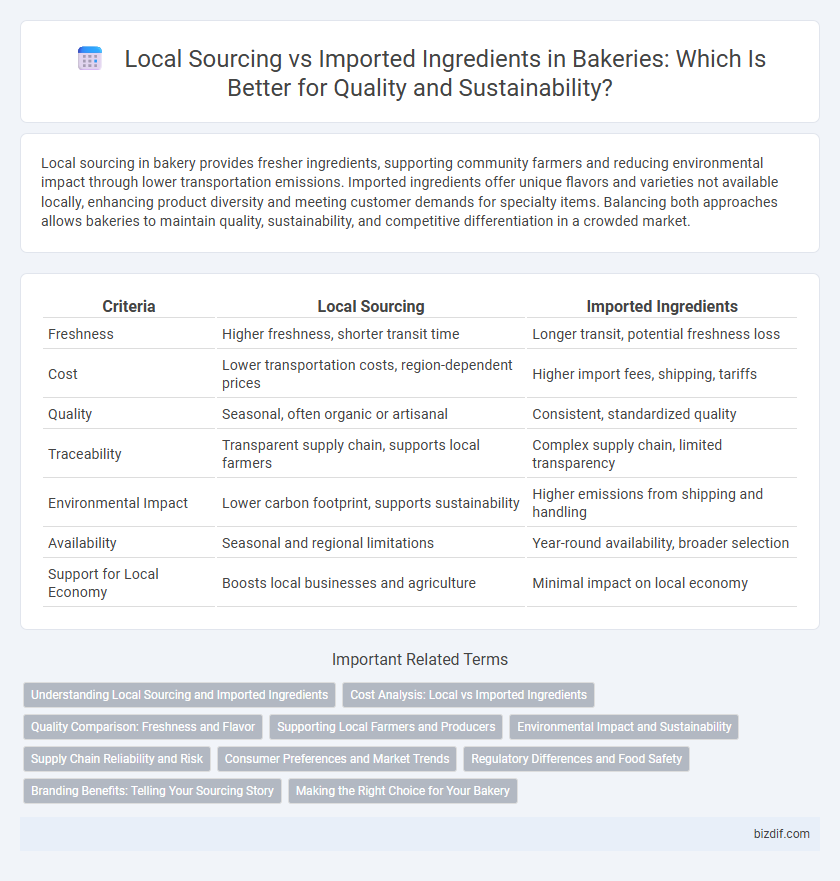Local sourcing in bakery provides fresher ingredients, supporting community farmers and reducing environmental impact through lower transportation emissions. Imported ingredients offer unique flavors and varieties not available locally, enhancing product diversity and meeting customer demands for specialty items. Balancing both approaches allows bakeries to maintain quality, sustainability, and competitive differentiation in a crowded market.
Table of Comparison
| Criteria | Local Sourcing | Imported Ingredients |
|---|---|---|
| Freshness | Higher freshness, shorter transit time | Longer transit, potential freshness loss |
| Cost | Lower transportation costs, region-dependent prices | Higher import fees, shipping, tariffs |
| Quality | Seasonal, often organic or artisanal | Consistent, standardized quality |
| Traceability | Transparent supply chain, supports local farmers | Complex supply chain, limited transparency |
| Environmental Impact | Lower carbon footprint, supports sustainability | Higher emissions from shipping and handling |
| Availability | Seasonal and regional limitations | Year-round availability, broader selection |
| Support for Local Economy | Boosts local businesses and agriculture | Minimal impact on local economy |
Understanding Local Sourcing and Imported Ingredients
Local sourcing in bakery emphasizes using fresh, regional ingredients like flour, dairy, and fruits, which supports local farmers and ensures seasonal quality. Imported ingredients, such as specialty spices, exotic fruits, or unique grains, offer diversity and authentic flavors not available locally, enhancing product variety. Balancing both sourcing methods allows bakeries to maintain consistent quality while introducing distinctive tastes to their offerings.
Cost Analysis: Local vs Imported Ingredients
Local sourcing of bakery ingredients often reduces transportation costs and supports regional economies, resulting in lower overall expenses. Imported ingredients may offer unique flavors or higher quality but typically incur higher costs due to tariffs, shipping fees, and longer lead times. Evaluating cost efficiency requires balancing these expenses against product quality and consumer demand for authenticity or specialty items.
Quality Comparison: Freshness and Flavor
Locally sourced bakery ingredients often deliver superior freshness and enhanced flavor due to reduced transportation time and minimal storage. Imported ingredients may offer unique varieties but can suffer from degradation in taste and potency during long transit. Prioritizing local sourcing ensures higher quality, supporting vibrant flavors and consistent bakery product excellence.
Supporting Local Farmers and Producers
Supporting local farmers and producers strengthens the bakery's supply chain by ensuring fresher, high-quality ingredients like seasonal fruits, organic grains, and artisanal dairy products. Local sourcing reduces transportation emissions and supports sustainable agriculture, contributing to environmental stewardship and community well-being. Emphasizing local partnerships enhances transparency and promotes economic resilience within the region's food ecosystem.
Environmental Impact and Sustainability
Local sourcing in bakeries significantly reduces carbon emissions by minimizing transportation distances and supports regional agriculture, enhancing sustainability. Imported ingredients often involve extensive shipping and refrigeration processes, leading to a larger carbon footprint and increased environmental impact. Prioritizing local ingredients promotes eco-friendly practices, reduces packaging waste, and ensures fresher, more sustainable bakery products.
Supply Chain Reliability and Risk
Local sourcing in bakeries ensures supply chain reliability through shorter delivery times and reduced transportation risks, minimizing delays and spoilage. Imported ingredients introduce variability due to longer transit routes, customs regulations, and geopolitical factors, increasing vulnerability to disruptions. Balancing local and imported sources can mitigate risks by diversifying suppliers and enhancing inventory flexibility.
Consumer Preferences and Market Trends
Consumer preferences in the bakery industry are increasingly favoring locally sourced ingredients due to growing awareness of sustainability, freshness, and supporting local farmers. Market trends indicate a surge in demand for artisanal baked goods made with organic, regional grains and seasonal produce, reflecting a shift toward transparency and quality. Imported ingredients remain popular for specialty flavors and exotic varieties, but the overall trend emphasizes traceability and ethical sourcing aligned with consumer values.
Regulatory Differences and Food Safety
Local sourcing in bakery ingredients often ensures compliance with domestic food safety regulations such as the FDA's Food Safety Modernization Act (FSMA), enabling more transparent traceability and fresher quality control. Imported ingredients face varied regulatory standards depending on their country of origin, requiring stricter customs inspections and adherence to international food safety certifications like HACCP and ISO 22000 to prevent contamination risks. Understanding these regulatory differences is crucial for bakeries to maintain product safety, quality consistency, and compliance throughout their supply chain.
Branding Benefits: Telling Your Sourcing Story
Emphasizing local sourcing in bakery branding enhances authenticity and fosters customer trust by highlighting fresh, community-supported ingredients. Showcasing transparent origin stories differentiates your bakery from competitors relying on imported components. This strategy builds emotional connections, reinforcing brand loyalty and attracting discerning consumers who value sustainability and quality.
Making the Right Choice for Your Bakery
Choosing local sourcing for bakery ingredients enhances freshness and supports community farmers, often resulting in superior flavor and seasonal variety. Imported ingredients may offer unique flavors and consistency but can increase costs and carbon footprint due to transportation. Prioritizing locally sourced grains, dairy, and produce aligns with sustainable practices and appeals to consumers valuing authenticity and environmental responsibility.
Local Sourcing vs Imported Ingredients Infographic

 bizdif.com
bizdif.com